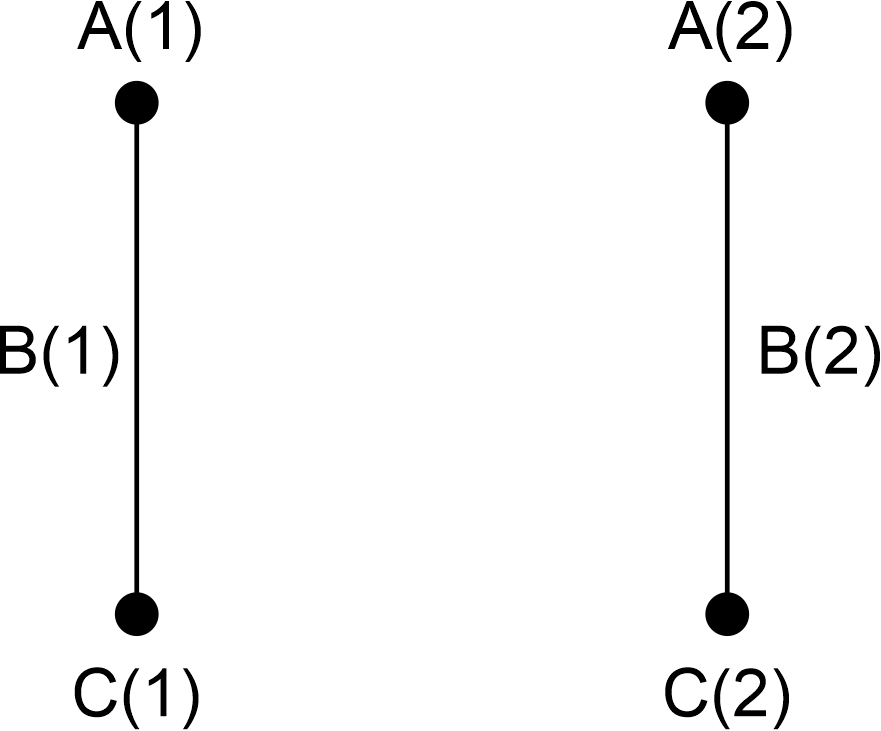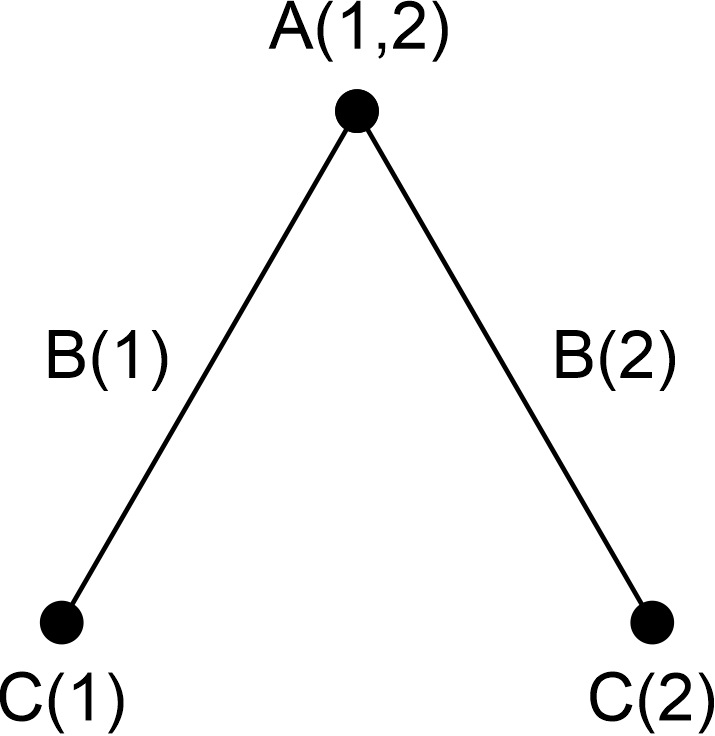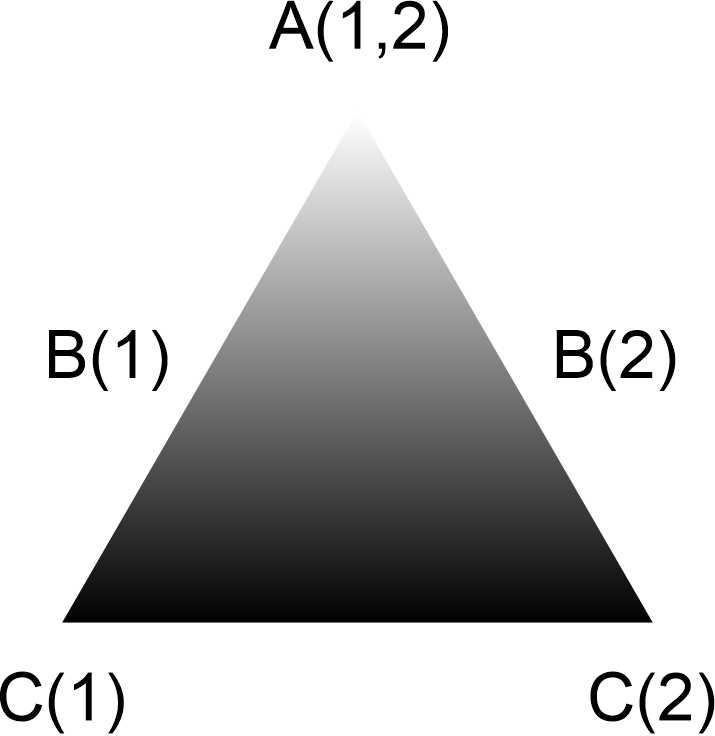- Title: Contemplations, The Triangle of Choice.
- Author: Arvindus.
- Publisher: Arvindus.
- Copyright: Arvindus, 2017, all rights reserved.
- Index: 201705151.
- Edition: html, first edition.
The One Fate
In earlier contemplations choice was presented as relating fate to accidence.1, 2 Now since individual people make their own choices one may be tempted to picture a mental image as in figure 1 where different accidents are related to different fates by different choices. In this figure letter A represents fate, letter B choice and letter C accidence. Number 1 represents a first human and number 2 a second human.

Figure 1.
It must however not be forgotten that accidence is related to matter and the personality, choice to consciousness and the soul and fate to spirit and the monad. And it can also be said that accidence is related to physicality and fate to metaphysicality. And physicality regards a multiplicity while (the border to) metaphysicality regards a unity.3 Spirit regards essentially a unity.4 This then makes that the fate of one human cannot be seen isolated from the fates of others. The fate of every human is essentially one with the fate of the whole of humanity. This is an idea which is also beautifully present in Heidegger's thought about 'Geschick'.5 An image such as in figure 2 then is more accurate than the one in figure 1.

Figure 2.
In this figure 2 we see how different accidences (C(1) and C(2)) are related through different choices (B(1) and B(2)) to one shared fate (A(1, 2)).
Up till now the numbers 1 and 2 were taken to represent different humans with their own accidences C and their own choices B. However different accidences and different choices may also occur with one and the same individual. The numbers 1 and 2 then are taken to represents different points in time, where it can be said that before they were taken as representing different points in space. 'Space' here must be understood as the space which one specific physical body occupies; different bodies occupy different spaces. Now when the numbers 1 and 2 are taken as different points in time we see one human relating the two accidences of C(1) and C(2) to his individual fate A(1, 2) though the choices B(1) and B(2).
So where in the first conception of figure 2 the numbers 1 and 2 were taken to represent different spaces they were in the second conception taken to represent different times. However it is also possible to conceive these numbers as representing differences in time and space. Then two interpretations become possible, depending on how A is interpreted. When A is taken to represent the one fate of humanity the numbers 1 and 2 represent two humans in different points of time. When however A is taken to represent the one fate of one individual the numbers 1 and 2 represent two different incarnations of the same human. For in different incarnations humans take on different space occupying bodies in different points of time.
The Graduality of Choice
In figure 2 is depicted how different accidences are related to one fate through different choices. It must be understood however that true accidences stand fully on themselves. An accidence is only an accidence when it is not brought about by choice. Here it must be put clear that the molding of accidences by choices of a human happens gradually. Dependent upon the point of evolution of the regarded human will his consciousness be more material or more spiritual,6 and likewise will his choice be. Someone with a young history of evolution will tend to be more ruled by accidence, someone with an old history of evolution will tend to be more ruled by fate, and someone in the middle will be at the apex of choice making.
Figure 3 symbolizes the above. The single fate A is symbolized by the white color, the plural accidences C are symbolized by the black color and the choices B are symbolized by the grey colors.

Figure 3.
We see that in occurrences in human life nothing is radical accidental or radical fatal. For then there would be no individual choice making consciousness, and it is exactly such an individual consciousness which is characteristic for a human being.7, 8 Radical accidence only occurs in sub-human kingdoms and radical fatality only in supra-human kingdoms. From this perspective it is correct to state that all occurrences in human life are chosen. However such statements are only in place against the background knowledge that usually choices are tinged in more or lesser degree by the blackness of accidence or the whiteness of fate. It is only with humans standing in the middle of their human evolution (from the 'developed man' or 'integrated personality' to the 'initiate' of the secret wisdom teaching) that choices will be dominantly true choices.
The Arc of Evolution
Above humans were already depicted as evolving. They are, so to speak, placed on the upward arc of evolution leading them from matter to spirit (in contrary to the downward arc of involution which leads them from spirit to matter).9 This means that spirit will gain rule over matter through consciousness, and this also means that fate will gain rule over accidence through choice. All in all it is intended for accidence to be directed by choice and for choice to be ruled by fate.
All of the above has implications for the nature of choice. In an early human evolution choice shall still be partly moved by accidence while in a later human evolution it shall be partly ruled by fate. Choice then can be of the nature of a true choice at its apex, of the nature of a sub-choice when partly moved by accidence and of the nature of a supra-choice when partly moved by fate. Sometimes humans think they consciously choose while in reality they are very much motivated by their accidental tendency.10 And at other times they think they consciously choose while they are actually led by fate in making their presupposed choice.
The latter case is interesting to ponder on when choice is considered as karma and in its twofold division, namely the division of cause and effect.11 Again we recall figure 2 in which A was considered to represent the one human fate. But this time we let 1 stand for cause and 2 for effect. We now interpret how the objective cause C(1) through subjective cause B(1) is related to fate A(1, 2), which again through subjective effect B(2) relates to objective effect C(2).
From this, along with what has been stated in other contemplations anent choice, the following can be deduced. Firstly (in random order) it can be deduced that the movement of accidence by choice transforms the first into objective causes and effects. This can easily be accepted. Any objective occurrence based upon choice (be it an objective cause or an objective effect) can be perceived as overpowering random accidences. Secondly it can be deduced that the one human fate stands behind the law of karma. For it is fate A(1, 2) which brings occurrence C(1) in relation to occurrence C(2). This is why the effect of karma is often confusingly called 'fate'. The effect of karma is inescapable because it is fate ruling the relation between cause and effect. Thirdly it can be deduced that it is the subjectivity in choice or karma through which fate relates objective occurrences to each other. This is why in teachings on karma and spirituality the emphasis in actions is laid on motive and not on the fruit of one's action.12 Other deductions can be made too, but the present three shall suffice for now.
Notes
- 'Contemplations, Destiny, Choice and Accidence Contextualized in the Ageless Wisdom', Index: 201309091.
- 'Contemplations, Choice and Destiny as a Ninefold', Index: 201510162.
- 'Contemplations, A Setup for a Metaphysicratic Manifest', Index: 201204032.
- Alice A. Bailey, Esoteric Psychology, Volume I, A Treatise on the Seven Rays, Volume I, in: Twenty-Four Books of Esoteric Philosophy, (CD-ROM, Release 3), Lucis Trust, London / New York, 2001, p. 6. "Spirit is One, but within that essential unity the "points of fire" or "the divine sparks" can be seen and noted. These unities, within the unity, […]."
- Michael Inwood, A Heidegger Dictionary, Blackwell Publishers Ltd, Oxford / Massachusetts, 1999, p. 67-69.
- 'Ageless Wisdom, Classifications of Humanity', Index: 201404081.
- 'Ageless Wisdom, Man on the Planes', Index: 201212031, The Planes, Consciousness and Entities.
- 'Contemplations, Consciousness and the Threads: A Short Sketch with Drawings', Index: 201509042.
- 'Ageless Wisdom, Cycles', Index: 201403131.
- Nota 2.
- 'Contemplations, Choice and Karma', Index: 201607111.
- Alice A. Bailey, The Light of the Soul, in: Twenty-Four Books of Esoteric Philosophy, (CD-ROM, Release 3), Lucis Trust, London / New York, 2001, p. 285. "2. The effect involves no Karma, for the act has been done from a selfless motive and carried out with complete detachment."
Bibliography
- 'Ageless Wisdom, Classifications of Humanity', Index: 201404081.
- 'Ageless Wisdom, Cycles', Index: 201403131.
- 'Ageless Wisdom, Man on the Planes', Index: 201212031.
- 'Contemplations, A Setup for a Metaphysicratic Manifest', Index: 201204032.
- 'Contemplations, Choice and Destiny as a Ninefold', Index: 201510162.
- 'Contemplations, Choice and Karma', Index: 201607111.
- 'Contemplations, Consciousness and the Threads: A Short Sketch with Drawings', Index: 201509042.
- 'Contemplations, Destiny, Choice and Accidence Contextualized in the Ageless Wisdom', Index: 201309091.
- Alice A. Bailey, Esoteric Psychology, Volume I, A Treatise on the Seven Rays, Volume I, in: Twenty-Four Books of Esoteric Philosophy, (CD-ROM, Release 3), Lucis Trust, London / New York, 2001.
- Alice A. Bailey, The Light of the Soul, in: Twenty-Four Books of Esoteric Philosophy, (CD-ROM, Release 3), Lucis Trust, London / New York, 2001.
- Michael Inwood, A Heidegger Dictionary, Blackwell Publishers Ltd, Oxford / Massachusetts, 1999.